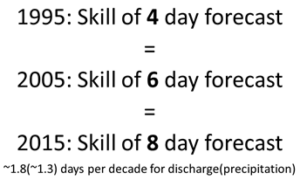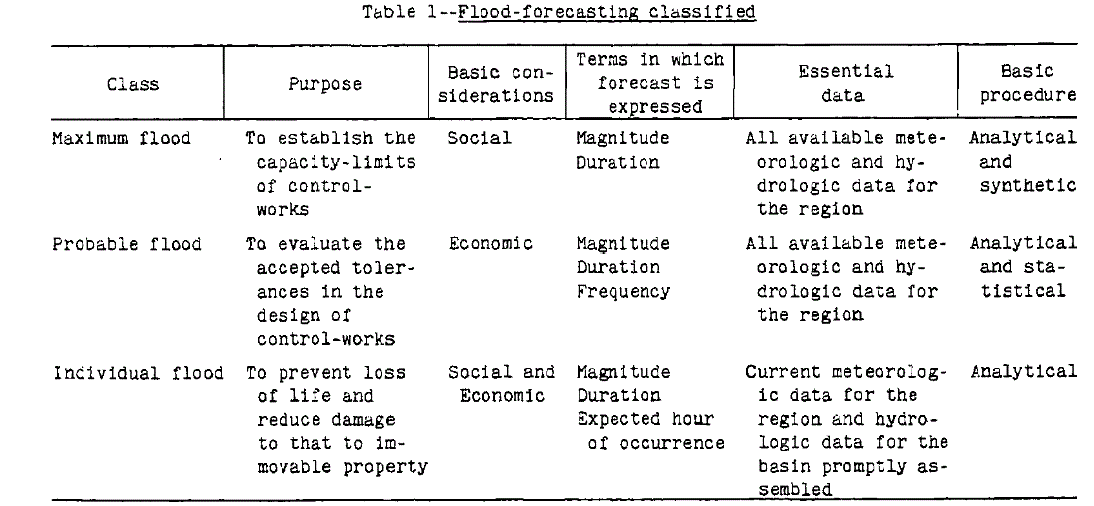Comparing forecasting in 1939 to today
“From the prophecies of the Ancients to the crystal-gazing of the Moderns, man’s urge to know his fate has been in opposition to the wisdom of a Providence that mercifully cloaks the future and reduces the outlook largely to speculation; and flood-forecasting, in the general sense, is an example of this characteristically human effort to foretell events.” [1]
We pride ourselves on improving forecasting from year to year. We can show that discharge forecasts improves by roughly 1.8 days a decade (see figure). Using some crude extrapolation, this means that a discharge forecast for day 1 in 1939 would have the same quality as a 13-day forecast today…. but is there anybody who would issue warnings to the public based on a 13-day forecast?
Improvements in discharge forecast according to published literature
Still, hydro-meteorological forecasting was used in 1939, which is illustrated by publications in Transactions of the American Geophysical Union (see references below). We can see that procedures of flood forecasting are extremely similar. The detailed description of such procedures by [1], for example, has so much similarity with today that large parts of what the author describes could be copied straight into a modern handbook. And many of the other issues we face today have not really changed since then. Here are some examples.
Model vs forecaster
The role of the model and the forecaster has been already debated then – although slightly along different lines in contrast to our current contributions to HEPEX (see posts by columnists) as the models and hydrological theory (and computer power) were not at the same level as today (e.g. the unit hydrograph idea was still novel):
“For nearly a century, engineers relied upon empirical formulas to express the rainfall runoff relation. Good judgment and experience was required to approximate the effects of the complex variables intervening between rainfall and runoff. To the credit of many of these engineers, the history of their works has confirmed their judgment. It has not confirmed their formulas.” [2]
(Un)certainty
In 1939, uncertainty in the forecasts was recognized, but a certain future is envisaged:
“it has to be admitted that completely reliable information of this sort cannot be issued more than a few hours in advance” [3].
“In spite of the advances that have been made in forecasting, the day of 100 per cent verification of forecasts, even those for just a few hours ahead, is far from achievement.”[3]
User Orientation
Today as in 1939, users, usage and purpose is at the heart of flood forecasting. In 1939, the purpose of a forecasting system formed part of a classification system (see figure below), which is very different from our classifications today, where we seem to focus more on the type of events and temporal forecast horizon.
Classification of flood forecasting [2]
“Forecasting […] prevents […] losses […] from floods. It is essential to the efficient operation of storage-reservoirs for flood-control. Substantial savings accrue from the present forecasting system for both purposes, but full realization of the potentialities of forecasting is hampered by lack of hydrologic data and techniques, and by lack of requisite support for making the forecast and for assuring intelligent use of the forecast.” [4 – this is actually quoted straight from the abstract, which does a disservice to this paper as it is worth reading in full!]
Then and today, decision making systems which allow us to issue warnings from forecasts are important. Collaboration with all disciplines involved is as essential then as it is today.
So what has changed?
Actually (and contradicting myself), a lot! It ranges from our understanding of hydrology and meteorology, our computer codes and capabilities and understanding of uncertainty … to name a few. I deliberately focused on similarities in this short blog post – if you want to find dissimilarities, then read the papers!
“It has been demonstrated that a well-trained meteorologist and hydrologist working in close cooperation can achieve remarkable success with the meteorological information at hand.” [3]
References
[1] Sherman, LK, Recent advances in applied hydrology with reference to flood forecasting, Transactions of the American Geophysical Union, Volume: 20 Pages: 174-176 Part: 2 Published: JUL 1939 [link]
[2] Bernard, M, Recent developments in flood forecasting, Transactions of the American Geophysical Union, Volume: 20 Pages: 187-193 Part: 2 Published: JUL 1939 [link]
[3] Byers, HR , The meteorological phase of flood forecasting, Transactions of the American Geophysical Union, Volume: 20 Pages: 205-207 Part: 2 Published: JUL 1939 [link]
[4] White, GF , Economic aspects of flood forecasting, Transactions of the American Geophysical Union, Volume: 20 Pages: 218-233 Part: 2 Published: JUL 1939 [link]


0 comments